skills acTion Plan for The food and Beverage secTor - Department of ...
skills acTion Plan for The food and Beverage secTor - Department of ...
skills acTion Plan for The food and Beverage secTor - Department of ...
You also want an ePaper? Increase the reach of your titles
YUMPU automatically turns print PDFs into web optimized ePapers that Google loves.
<strong>and</strong> science <strong>and</strong> technology’s ability to provide solutions<br />
‘palatable’ to a wide range <strong>of</strong> consumers).<br />
Increasing dem<strong>and</strong> <strong>for</strong> vegetable-based <strong>food</strong>s that<br />
combine health, style <strong>and</strong> convenience can best be<br />
met by growers <strong>and</strong> processors developing <strong>skills</strong> <strong>and</strong><br />
networks to make use <strong>of</strong> science, technology, marketing<br />
<strong>and</strong> organisational innovations. <strong>The</strong>se innovations are in<br />
relation to growing produce; environmental management;<br />
underst<strong>and</strong>ing emerging market dem<strong>and</strong>; adding value<br />
in processing, storage <strong>and</strong> packaging; <strong>and</strong> enabling more<br />
efficient distribution to maintain freshness, goodness,<br />
flavour <strong>and</strong> appearance.<br />
A two-phase approach to the research has been adopted.<br />
Phase one has been completed with findings outlined below.<br />
<strong>The</strong> first phase aimed to help stakeholders underst<strong>and</strong><br />
<strong>and</strong> be able to take action to improve adoption rates.<br />
In the first instance it is exploring the range <strong>of</strong> attitudes,<br />
behaviours, <strong>skills</strong>, relationships, <strong>and</strong> networks that decision<br />
makers <strong>and</strong> ‘ground floor’ staff need in order to assess:<br />
• <strong>The</strong> potential <strong>of</strong> an innovation.<br />
• <strong>The</strong> nature <strong>of</strong> the change process that would be<br />
involved in adopting it.<br />
• <strong>The</strong> requirements <strong>for</strong> successful implementation.<br />
It also sought to underst<strong>and</strong> the impact that the presence<br />
or absence <strong>of</strong> highly qualified staff or PhD students has on<br />
assessment, change management <strong>and</strong> implementation. <strong>The</strong><br />
research looked at the impact <strong>of</strong> organisational culture<br />
<strong>and</strong> organisational practices on openness to adoption, <strong>and</strong><br />
adoption rates.<br />
Key findings from phase one are:<br />
• <strong>The</strong>re appear to be three primary drivers as to<br />
how open or otherwise businesses are to adopting<br />
science <strong>and</strong> technology. <strong>The</strong> most significant is the<br />
focus on survival, either through increasing efficiency<br />
or matching competitors’ products. <strong>The</strong> second is<br />
that lack <strong>of</strong> scale means using cash flow rather than<br />
debt/equity to fund improvements, which biases<br />
investment towards incrementalism rather than<br />
disruptive innovations. <strong>The</strong> third is the impact <strong>of</strong> the<br />
characteristics <strong>of</strong> the owner or manager – the higher<br />
their levels <strong>of</strong> confidence <strong>and</strong> vision to take risks, <strong>and</strong><br />
analytical <strong>skills</strong> <strong>and</strong> education, the more likely it is they<br />
will adopt science <strong>and</strong> technology.<br />
• Secondary drivers include the:<br />
• Speed with which investment decisions can be made.<br />
• Style <strong>and</strong> structure <strong>of</strong> management.<br />
• Level <strong>of</strong> in-house scientific <strong>and</strong> technical expertise;<br />
where high transaction costs with sourcing seasonal<br />
staff lead to technology substitution <strong>for</strong> labour.<br />
• Difficulties to do with the availability <strong>and</strong> suitability<br />
<strong>of</strong> labour where it has been a factor in decisions<br />
to increase levels <strong>of</strong> automation so as to reduce<br />
reliance on labour. This is in part to do with the<br />
seasonal nature <strong>of</strong> the industry, especially in growing<br />
where there is no guarantee that next year’s labour<br />
pool will be the same as last year’s, leading to<br />
significant transaction costs.<br />
• At the commodity growing <strong>and</strong> processing end <strong>of</strong><br />
the vegetable industry value chain, there are well<br />
established systems, processes <strong>and</strong> networks<br />
supporting the adoption <strong>of</strong> technology <strong>for</strong> survival<br />
(<strong>for</strong> now).<br />
• Few companies are targeting niche local <strong>and</strong> export<br />
markets with high quality <strong>and</strong> differentiated products,<br />
where science <strong>and</strong> technology adoption (innovation)<br />
are critical success factors, <strong>and</strong> the real returns lie.<br />
This appears to relate to there being no apparent<br />
modus oper<strong>and</strong>i or development pathway available <strong>for</strong><br />
new products <strong>and</strong> <strong>for</strong> creating the value chain needed<br />
to get them to market successfully. Furthermore,<br />
large scale science <strong>and</strong> technology adoption, to drive<br />
economic trans<strong>for</strong>mation, requires the industry as<br />
a whole to develop the willingness <strong>and</strong> capability to<br />
30



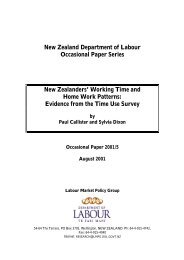

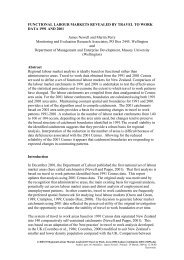
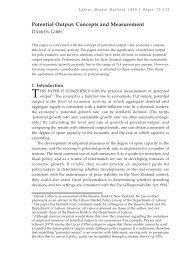

![a note on levels, trends, and some implications [pdf 21 pages, 139KB]](https://img.yumpu.com/27285836/1/184x260/a-note-on-levels-trends-and-some-implications-pdf-21-pages-139kb.jpg?quality=85)


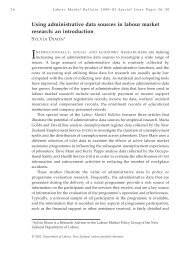


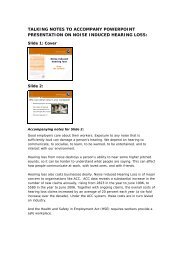
![Labour Market Trends and Outlook - 1996 [pdf 18 pages, 94KB]](https://img.yumpu.com/27285764/1/184x260/labour-market-trends-and-outlook-1996-pdf-18-pages-94kb.jpg?quality=85)

